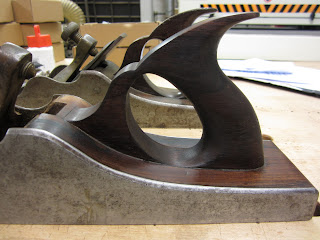Sunday, 9 December 2012
Spiers Plane, Repair Refurbishment
Yesterday I was finishing and packing a batch of dovetail guides when I decided to throw in this little project to add some interest to the day. It is a 13 1/2" panel plane by Spiers with a 2 1/2" wide original Ward iron. This is a common size but is a very useful plane capable of the finest smoothing as well as flattening smaller boards. It is comfortable and heavy with a very fine mouth.
Of course the only drawback was this badly damaged spur but at £135 it was a good buy (I hope!).
This brings me to the time involved in making these repairs, if you are doing it for fun then take your time and enjoy the process. If you're looking to make a good return on the time spent, then you need to keep an eye on the clock and learn which planes to buy and which to leave alone.
As the spur had quite bad damage on both sides then I decided it would be quicker and better to take it straight off. I did this on the table saw with base running against the fence, remembering to remove the blade and lever cap screw!
Using the table saw has the advantage of quickly giving you a clean flat surface to glue to but also one which is dead parallel to the sole making clamping much easier.
Shaping the elegant spur is made a lot easier if you have another plane to copy. The one in the background is a Spiers plane from around 1890-1910, whereas the one I'm working on is slightly later around 1910-1920, although the profiles are remarkably similar.
The wood in the foreground is some old Rio (Brazilian) rosewood which should give a nice match to the original handle.
My glue of choice is this resin glue which dries rock hard and avoids the tiny creep which seems to occur over time with yellow glue. This creep can turn a near invisible repair into an obvious one and spoil your hard work. Epoxy will also work well.
Here is the clamp up, easy and solid. I applied good pressure but didn't go too far just in case I ended up with another repair as well! Getting to this stage had taken just 15 minutes, all going well so far.
Here is the glued on block after 5 hours left in a warm place (not my workshop!). I've marked out the profile of the new spur ready for cutting on my smaller band saw.
With the top and bottom cuts done on the band saw I marked out the profile of the rounded part. The rough shaping was done with rasps, I found the round Micro Plane rasp the most useful and finished off with a fine Auriou hand stitched rasp.
A combination of machine sanding (I don't know what I would do without my Kirjes pneumatic drum sander) and hand sanding to 320 grit and the whole rear section was ready for finishing. The time taken getting to this stage was 75 minutes. The match of the bare wood was good and there was a barely visible glue line which should disappear with the finish. The profile of the curve was slightly flatter than the earlier plane but pretty close.
Another view.
I applied a first coat of finish (melamine lacquer) to get a good look at the finished colour and all was well.
This left the front bun to be re finished so that everything matched and three more thin coats of Osmo Hard Wax Oil to be applied. By the time I have touched up the metal work, cleaned and sharpened the blade it will have taken three hours work and should be a reasonable investment as well as a fine looking and very useful plane.
Subscribe to:
Post Comments (Atom)













This comment has been removed by the author.
ReplyDeleteHello David, I have some Ercol furniture I wish to re-finish, there are a lot of round sections to sand, the chair backs are made up of dowel sections and the legs and rungs are round section. Do you think the Kirjes sander would be suitable for this task?
ReplyDeleteRegards, Mark
Hi Mark,
DeleteIt will cope well and certainly speed things up. Use the drums nice and soft and don't use a heavy grit as it removes wood very quickly!
All the best, David.
Thanks David.
Delete